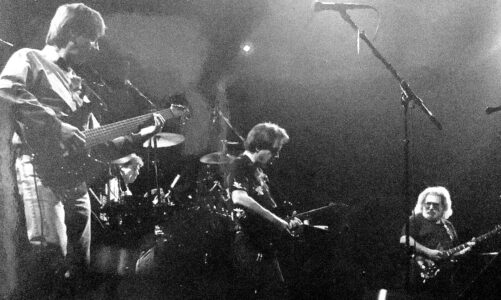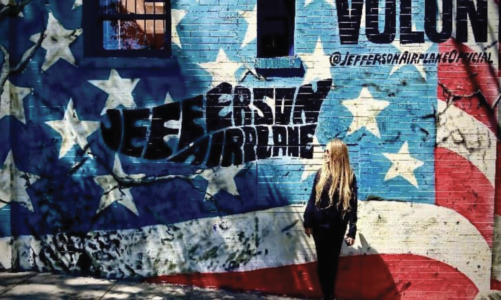Just in time for Spring, there’s a Counterculture Musuem about to bloom on the corner of Haight and Ashbury. Jerry and Estelle Cimino — the folks behind the Beat Museum in North Beach for 20 years — have been dreaming up this new adventure since 2019, and when this particular location opened up, the synchronicity wasn’t lost on them. A big fan of the Beat Museum, I had a lovely hang with Jerry and Estelle back in January as they gave me a tour of the new joint, still a work-in-progress at that point.. They’re aiming for a late-April, early May opening, so stay tuned!
Hop on the Haight Street Voice bus and support local journalism!
[Video above: Owner Jerry Cimino give Haight Street Voice an exclusive tour of the Counterculture Museum whilst the vast space is still coming together for the grand opening later this Spring!]
Jerry Cimino: Counterculture is as old as civilization. The Greeks and the Romans had counterculture. We’re going to talk about what’s the difference between a counterculture and a subculture, and how the subculture sometimes becomes a true-blown society.
We’re gonna start here (gesturing to front area). This will be a Beat Generation case because that’s where we’re starting the story. We have the Beat Museum in North Beach.

Linda Kelly, Editor-in-Chief of Haight Street Voice, hanging at The Beat Museum, SF, 2024
Haight Street Voice: Yay Beat Museum!
JC: And the Beats became the Hippies. We’ll have a video here so people have the chance to review and understand the lineage of what happened in this era.
Then as we head on back, we’ll be doing the Civil Rights era. We’ll talk about what happened on the national stage as well as what was happening here in the San Francisco Bay Area, because the Bay Area has a very rich tradition.
We’ll have rotating exhibitions here in the back. The first one we expect to present will be the San Francisco Oracle. We have eight of the original twelve Oracles. This is a magnificent one of the Houseboat Summit. We’ve got a lot of stories to tell!
HSV: What is the task of counterculture moving forward?
JC: It’s the artists and their free spirits and the young who push society forward. It’s the people who put their own passion and perspective into things to show what can be, and typically it’s been the young. Every generation wants to do something different than its parents did. And in the sense of the counterculture, people try out different things and sometimes things stick.
For me, counterculture is basically people who think that they can have a sense of their own lives, what’s important to them, live in a more free way and dig into what they wanna dig into — whatever it may be. It’s kind of like the spirit of the Beats. “We don’t care who you are, what you look like, or what you’re into as long as you’re not hurting anybody else. Come join our party!”
That’s why the Hippies were so embracing. That was the whole idea behind Woodstock. Five-hundred thousand young people show up and there’s no violence, there’s no trouble. There’s people getting high or doing whatever they’re doing, but nobody got uptight about it. Even in the rainstorm, it was just a good weekend for most people.
And the legacy lives on.
We’ve had a museum for 20 years, we know how to tell a story. Estelle and I have talked about a lot of things we could be doing with the rest of our lives, but for us this is important because it empowers people. It let’s people realize they’re not alone and you can learn from what happened in the past and you can make choices for the future. That’s why we’re doin’ it.
HSV: I know a lot of people are excited that this is going to be a place you can come hang out, you can learn, you can read a book. It’s a place to land.
JC: Yeah, the people in the neighborhood have a special place. People who are visiting from overseas or other parts of the country, they might just be here for a day and they’re gonna wanna tour the museum and see all the exhibits and spend maybe a few hours here. It’s the locals that’ll probably come for book signings and other events that we’ll be hosting. We’re going to cater to a lot of different levels — just like we’ve done at the Beat Museum. Meeting people where they are and being open to what people want. We don’t claim to have all the answers for anything, and we’re very much open to ideas!
HSV: Estelle, what does counterculture mean to you?
EC: I really believe counterculture is about going against the grain of what is considered “normal.” It’s people living their truth, it’s people being authentic to who they are and what they want to happen in their lives and the lives of others in the world. It isn’t always what the government tells us or what parents tell us growing up.
When I was a kid I was way too young to be part of hippies and everything else, but I saw all the hippies and I admired the fact that they seemed so free and they could do what they wanted. It was just so appealing. I told my parents, “When I grow up I wanna be a hippie!” I really didn’t want to be a hippie, but I wanted to live that lifestyle, be that person who could live free without somebody telling them what to do all the time and how to do it. I believe we all should live our authentic selves. Of course there’s some things … don’t kill one another, don’t harm one another — I believe in those things. But beyond that, it’s what is your truth and try to move towards that truth.
JC: We’re a history museum and we don’t shy away from the truth. History teaches you.
HSV: And this museum is going to inspire people to remember.
JC: We hope so! We hope people remember what happened in the ‘60s and reclaim their power to make positive change for themselves, for our society, and for the world.
EC: We want to empower people — inspire and empower. We don’t want to fight against things, we want to fight for what we want. Let’s take action for what we want. That’s what we’re about: Showing how the past can inspire today and the future. The stories of the past are wonderful. We’re excited to tell those stories.
HSV: What do you want to say to the Haight community?
JC: We’re thrilled to be here, and we really have felt an extremely warm welcome by people in the community — from other merchants, people who live in the neighborhood, people who literally live on the street. We just want to be a part of your community. We didn’t live here in the ‘60s, and yet we understand, we think, what the story is, and we invite you and encourage you to tell us your story, tell us what we might be missing. What’s the flavor of this? What’s the twist to that story? We want to tell the good, powerful, unique story that literally started at this intersection (pointing out the window) and went around the world!
EC: Exactly. And we could still do the same thing today. We can make change!




